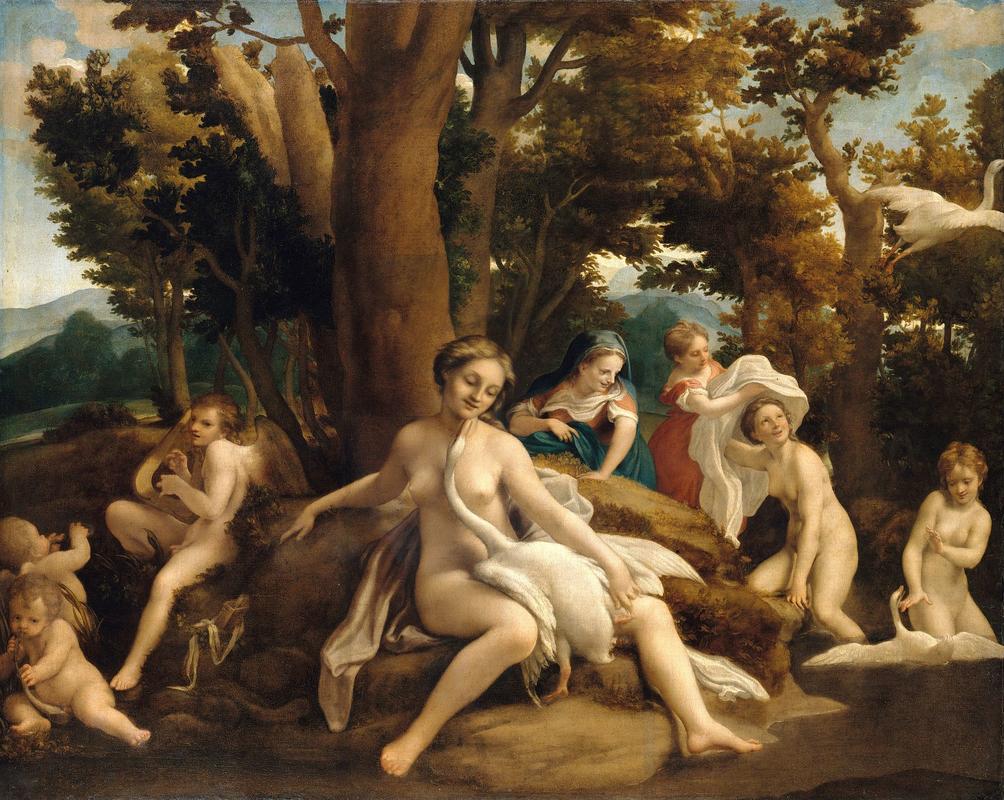More about Leda and the Swan

Contributor
Federico II Gonzaga, the fifth Marchese of Mantua, asked Correggio to paint this NC-17-rated image ofLeda and the Swan, set on the banks of the Greek Eurotas river.
This work is a member in a series of four images from Ovid's "Metamorphoses," which devotes only one line to the swan scene. Swedish troops took this picture as part of the spoils of war, along with Correggio's Danae, when they conquered Prague in 1648. As you can see, Leda and the swan are, to use the technical terms shtupping, or "gettin' it on," and she seems to be enjoying it. As the story goes, later that day Leda also had sex with her husband Tyndareus. This act, along with her episode with the swan, naturally led to her laying two eggs, from which hatched, according to some versions, Helen of Troy, Castor and Pollux, and Clytemnestra. Michelangelo, Leonardo da Vinci, Peter Paul Rubens, Paul Cézanne, Cy Twombly, and many others have also composed versions of this story, which they apparently found quite stimulating (creatively, of course).
By a bizarre twist of cultural irony, it is more acceptable, for some reason, to produce an image of a swan and a woman in a carnal embrace than an image of two mammals in the same position. My research has concluded that it's a conspiracy, orchestrated by secret swan councils, behind closed doors. It's also unacceptable, funnily enough, to portray a man holding a swan like Jason Biggs held the infamous pie in American Pie. This is because, as you know, swans are dominant in bed.
We tend to assume that we are living in days of increasing permissibility toward sex in art, but just recently a police officer saw a version of Leda and the Swan at the gallery co-owned by the family of Ron Wood from the Rolling Stones, and would not leave until they removed it, because encouraging bestiality is an arrestable offense in the U.K. "This was a popular form of erotica in Victorian times" was not a satisfactory rebuttal on the gallery's part, a representative of which told a newspaper, "It’s crazy. Perhaps the cultural references were lost on them.” Philistines!
Art history seeks to make itself a scientific discipline, in the sense that it can draw conclusions from testable hypotheses and physical evidence. Nonetheless, we're nowhere near finding a scientific method to analyze metaphors, which still occupy the majority of art writing, and this uncertainty is a mostly-hidden strength. It wouldn't be interesting to read about Leda and the Swan from a non-metaphorical perspective, partly because the story is so separate from what little reality we share a consensus about, especially as there are no longer many people who follow the Greco-Roman "mystery religions" which held this scene to be sacred. Aside from our ignorance as to whether Leda enjoyed this bestial congress, (which Correggio thought she did, and to such an extent that a Duke once cut her head out of the canvas, and a later restorer repainted it to appear less ecstatic) we are also ignorant as to whether this unusual union is connected to another ancient tradition. It is interesting that the divine human-bird sex by which Isis reanimates the seed of Osiris is uncannily similar.
Sources
- Bailey, Nathan. Ovid's Metamorphoses: In Fifteen Books; with the Notes of John Minellius, and Others, in English, with a Prose Version of the Author. Dublin: Wogan, 1815.
- Eissenhauer, Michael. "Lieblingsstücke des Generaldirektors: Leda mit dem Schwan." Staatliche Museen zu Berlin, 2015, https://blog.smb.museum/lieblingsstuecke-des-generaldirektors-leda-mit-….
- Furness, Hannah. "'Mythical' swan photo taken down after 'bestiality' fears." The Telegraph, Apr. 28, 2012, https://www.telegraph.co.uk/culture/art/art-news/9232512/Mythical-swan-….
- Gosetti-Ferencei, Jennifer Anna. The Ecstatic Quotidian: Phenomenological Sightings in Modern Art and Literature. University Park, PA: Penn State Press, 2007.
- Heaton, Mary Margaret. Antonio Allegri Da Correggio from the German of Dr. Julius Meyer. New York: MacMillan, 1876.
- Kren, Thomas, Jill Burke, and Stephen J. Campbell. The Renaissance Nude. Los Angeles: Getty, 2018.
- Marcuzzo, Maria Cristina, and Alberto Giacomin. Money and Markets: A Doctrinal Approach. London: Routledge, 2007.
Featured Content
Here is what Wikipedia says about Leda and the Swan (Correggio)

Leda and the Swan (known in Italian as Leda) is an oil on canvas painting from 1530–31 by the Italian painter Correggio, now in the Gemäldegalerie in Berlin. It shows three scenes of Leda's seduction by Jupiter who has taken the form of a swan. Their first meeting is shown on the right hand side and their lovemaking in the centre, where Leda sits with the swan between her thighs, guiding him with her left hand. They are accompanied to their left by Cupid with his bow and two cupids with flutes. The third scene (again on the right hand side) is the swan flying away whilst Leda gets dressed. Leda and the Swan was a common subject in 16th-century art.
Check out the full Wikipedia article about Leda and the Swan (Correggio)












